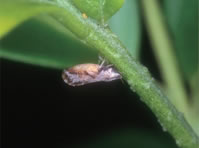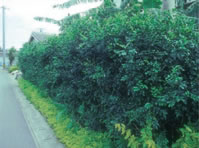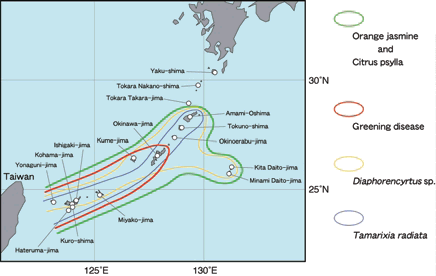The relationship between the distribution of citrus psylla, the vector insect of citrus greening disease, and the distribution of jasmine orange
Description
[Objectives]
Asian citrus greening disease, or "huang long bing", is the most significant obstacle to sustainable citrus production in tropical and subtropical Asian countries. The first detection of this disease in Japan was in 1988 on Iriomote Island, Okinawa. Subsequently, the disease spread throughout Okinawa prefecture.
The disease is transmitted by grafting or vector insects, like the Asian citrus psylla, Diaphorina citri (Fig. 1); therefore, controlling D. citri is an important step towards controlling the disease itself. D. citri is distributed throughout tropical and subtropical Asia and has also been recorded on major islands among the southwest islands of Japan. The host plants of D. citri are restricted to species belonging to the family Rutaceae. Among these species, Murraya paniculata, or "orange jasmine" (Fig. 2), and cultivated Citrus spp., are the most favored host plants.
In this survey, we investigated the distribution of cultivated Citrus spp., M. paniculata, D. citri, and its parasitic natural enemies on the islands within the southwest islands of Japan displayed in Fig. 3.
[Results]
Citrus spp. were found on all the islands investigated; however, M. paniculata and D. citri were found only on the islands located south of Amami-Oshima. On the islands where the distribution of D. citri was confirmed, at least one of the two species of parasitic natural enemies (an encyrtid wasp Diaphorencyrtus sp. and an eulophid wasp Tamarixia radiata) was found. Distribution of parasitic natural enemies represents the continuous occurrence of the host in the area. Therefore, it is concluded that D. citri maintains a continuous presence on the islands south of Amami-Oshima.
In conclusion, the most intensive efforts to prevent invasion by Asian citrus greening disease should be implemented in areas where D. citri is distributed, even if the disease has not yet been detected at the present time.
Figure, table
-
Fig. 1. Infecton of adult Diaphorina citri on Murraya paniculata. -
Fig. 2. Murraya paniculata“orange jasmine”planted as a hedge around a house. -
Fig. 3. Distribution of Murraya paniculata "orange jasmine", Diaphorina citri "citrus psylla", citrus greening disease "huang long bing", and two wasps parasitizing D. citri (Diaphorencyrtus sp. and Tamarixia radiata) on the Southwest Islands of Japan.
- Affiliation
-
Japan International Research Center for Agricultural Sciences Okinawa Subtropical Station
- Classification
-
Technical A
- Term of research
-
FY2001 (FY1998-2001)
- Responsible researcher
-
KOHNO Katsuyuki ( Okinawa Subtropical Station )
NAKATA Tadafumi ( Okinawa Subtropical Station )
TAKAHASHI Keiichi ( Okinawa Subtropical Station )
KONISHI Kazuhiko ( National Institute for Agro-Environmental Sciences )
YASUDA Koji ( National Institute for Agro-Environmental Sciences )
YOSHIMATSU Shin-ichi ( National Institute for Agro-Environmental Sciences )
- ほか
- Publication, etc.
-
K. Kohno, K. Takahashi, T. Nakata and K. Konishi (2002): Occurrence of the Aisan citrus psylla and its parasitic natural enemies in the Ryukyu archipelago, Japan. Acta Horticulturae, 575, 503-508.
- Japanese PDF
-
2001_24_A3_ja.pdf925.86 KB
- English PDF
-
2001_21_A4_en.pdf132.41 KB



